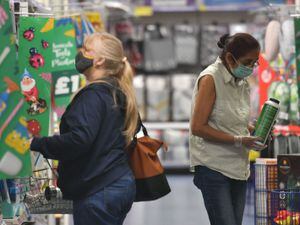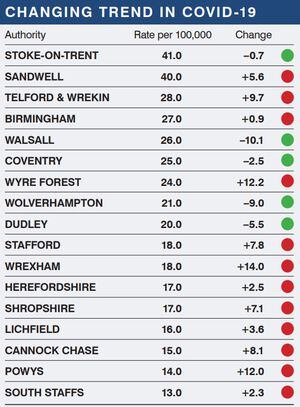Majority see Covid infections rise as restrictions eased
Coronavirus infection rates have increased in the majority of places across the Midlands over the past week, new figures have shown.

However, some areas previously seen as Covid hotspots have seen their rates drop.
Official data has revealed infections are slowly creeping up – with the rate almost doubling in some places – in the week up to April 22.
It comes after outdoor hospitality businesses and attractions, as well as non-essential retail, was allowed to open back up from April 12.
Health chiefs previously said the rise was to be expected as rules ease.
There is also a concern virus variants may cause the rate to rise.
Increases in the infection rate can be seen across Staffordshire, which includes Stafford, South Staffordshire, Cannock Chase and Lichfield.
Stafford saw 28 new positive Covid-19 cases being recorded, with 15 in South Staffordshire, 15 in Cannock Chase and 17 in Lichfield.
Meanwhile, in the Black Country, Sandwell is the only borough which has seen a rise – with Walsall, Wolverhampton and Dudley seeing the rate fall.
Sandwell saw 131 cases being recorded in the week, with 75 in Walsall, 56 in Wolverhampton and a total of 65 in Dudley, the figures have shown.

Figures have also been released for Shropshire, Telford and Wrekin – and both saw increases – with 51 and 54 cases being recorded respectively.
Powys, on the Shropshire/Wales border, saw an increase in its infection rate too.
Elsewhere, Birmingham and Wyre Forest both saw an increase in the Covid-19 rate, whilst there were decreases in the infection rate for both Coventry and Stoke-on-Trent.
Further rises were seen in Wrexham and Herefordshire.
Nationally, out of 315 local areas in England, 149 have seen a rise in rates.
Meanwhile, 150 have seen a fall and 16 remain unchanged, according to the data from Public Health England. Selby, in North Yorkshire, has the highest rate, with 101 new cases in the seven days to April 22 – the equivalent of 111.5 cases per 100,000 people.
This is up from 48.6 in the seven days to April 15, the largest increase in the country. Kirklees, in West Yorkshire, has the second highest rate, up from 61.8 to 68.9, with 303 new cases.
Doncaster has the third highest, down from 80.2 to 67.0, with 209 new cases.





